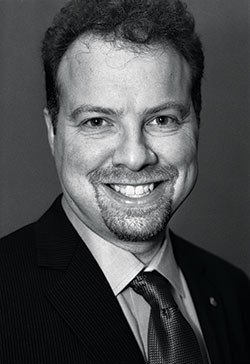Staying Curious: Adam Riess’s Nobel Journey
Fall
2018
Feature
Staying Curious: Adam Riess’s Nobel Journey
Diva Parekh, SPS Member, Johns Hopkins University
 Walking into Adam Riess’s office, I was immediately struck by the number of books. There were books everywhere: in a ceiling-high bookshelf, all over the desk, and on the chairs. I assumed they were all related to physics, but I couldn’t have been more wrong.
Walking into Adam Riess’s office, I was immediately struck by the number of books. There were books everywhere: in a ceiling-high bookshelf, all over the desk, and on the chairs. I assumed they were all related to physics, but I couldn’t have been more wrong.
Riess, who shared the 2011 Nobel Prize in Physics for discovering that the expansion of the universe is accelerating, has incredibly diverse interests. This became apparent when I asked him when he realized he wanted to do physics.
“I always had these questions of how or why something is,” he said. “What is fundamental? What is the basic law here from which everything derives? That approach, as I asked more questions, led naturally to physics.”
As an undergraduate at MIT, he majored in physics and minored in history. When I asked Riess if history is still a part of his life today, his eyes lit up.
“As scientists, we will really only confront a handful of research problems. When you seek wisdom or intuition, you may not have enough experiences to really gather that wisdom or intuition, so it’s wonderful to study the history of science,” he said.
He continued, explaining how scientists today can gain much-needed perspective from historical examples. Astronomers in the early 1800s observed that Uranus was not always where it was supposed to be, he said, which led to the discovery of Neptune. Mercury was not where astronomers initially believed it to be, which led to a confirmation of Einstein’s general relativity.
“Right now we’re seeing the expansion of the universe is faster than we expect. Is it a problem with the theory, or is it a problem with the components of the universe?” he said. “History, if anything, teaches you in science that you have to think critically.”
Thinking critically during his undergraduate labs helped lead Riess to where he is today. “I particularly gravitated towards data analysis as applied to physics hypotheses,” he said. “How is it that we collect a pile of numbers and we infer truth or reality from that?”
 Riess’s Nobel-winning research was a natural extension of what he had been working on since graduate school.
Riess’s Nobel-winning research was a natural extension of what he had been working on since graduate school.
“In my thesis, I had worked on tools involved in measuring the distances to exploding stars, supernovae. I began working with close collaborators on measuring even more distant supernovae,” he said. “There was an expectation that the expansion of the universe would be slowing or decelerating.”
He reinforced, however, that what earned him and his co-winners, Saul Perlmutter and Brian P. Schmidt, the Nobel Prize was not a sudden idea or a “Eureka” moment. Instead, it was persistence.
“It wasn’t an idea so much as it was a measurement. It was an observation that the expansion is actually accelerating or speeding up, not decelerating,” he said. “It came as a great surprise, and it came as a direct consequence of continuing to work on these tools for measuring distances to supernovae and data analysis.”
At the end of our meeting, I asked Riess if he had any advice for students like me.
“A passion for understanding is the best guide that you will have,” he said. “The best privilege you could get in your life is to have a job that you actually like, that you find interesting, that doesn’t feel like work.”

